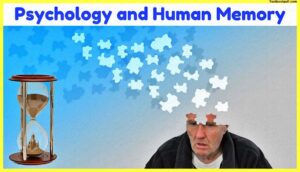Psychology and Human Memory
This article focuses on retrieval and matching conditions of encoding, Psychology and Human Memory and retrieval: Encoding specificity, State-dependent learning, and Transfer appropriate processing. We will talk about long-term potentiation, memory consolidation, and reconsolidation.
We have been talking about memory in the last few articles and in the last article we talked about encoding we especially talked about what are the different processes by which you can encode information to your long-term memory we talked about a variety of encoding processes and we showed through the use of these different experiments that how these different encoding processes the different kinds of encoding procedures can have an impact on your retrieval how good or how bad your retrieval of that content will be later.
In today’s article we will talk a little bit in more detail about retrieval and we will also talk about this mental function of memory is realized in the brain you would have noticed that in one of the earlier articles also we have been talking by and by about how different areas of the brain are involved in memory but we will try and do a more detailed analysis of that relationship.
What is retrieval?
So retrieval is basically when you’re trying to bring back information from your memory in order to use it or in order to describe it to somebody and so on and so forth one of the important aspects in retrieval is if you are presented with information that can help you retrieve that any content more easily or seamlessly so retrieval queues become very handy then what are retrieval cues retrieval queues are words or other stimuli that help us remember information that is stored in our memory say for example there is this excerpt I have taken from Goldstein and it describes a child’s going back to a place where he had spent some of his childhoods at his grandparent’s house and what he does is this child goes to that the grandparents house and kind of is moving around the house there are so many things in the house that will remind him of episodes and things that he experienced while he was let us say 8 years old 10 years old and was spending this holidays in that particular house.
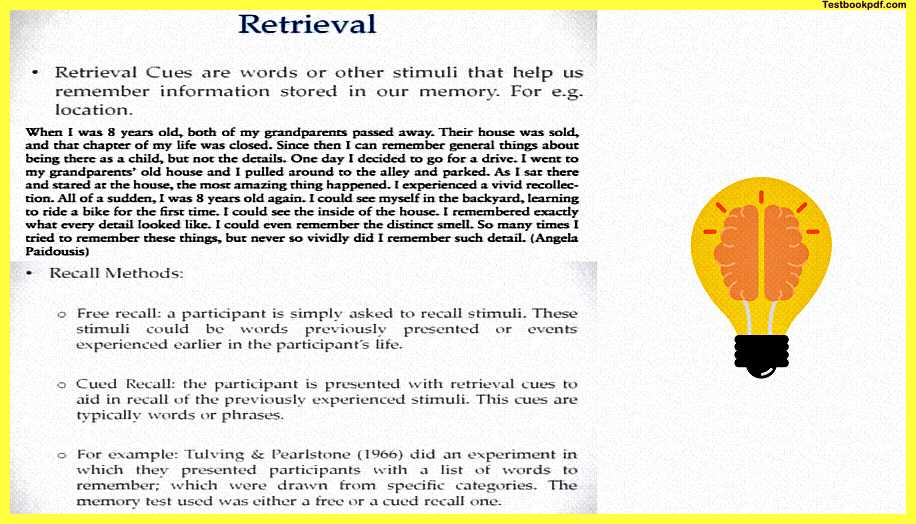
Now each of these stimuli each of these stimuli or say for example if there are words written or something like that at that place will act as cues of retrieval of that information that has been long past and apparently forgotten till this particular moment you might also recall say for example in your own experience if you meet somebody who you have not seen for 10 years or 5 years or 15 years maybe just the sight of that person reminds you of the kind of experiences you’ve had together of the kind of conversations you might have shared with each other and everything around that era kind of gets relived in just a flashback so this is basically what retrieval cues are now there are also different recall methods which might basically affect how well or how poorly you will recall particular kinds of information so i’ll just describe two kinds of recall methods to you so free recall is basically when a participant is simply asked to recall a stimulus if a participant is just said that whatever you learn in class today and the child has come home and maybe one of the parents is just asking repeat to me whatever you’ve learned in the class.
Now you’re not giving any cues you just asking this child to repeat straight out of his memory whatever about a particular subject that he or she might have learned in the school so these things these kind of stimulus that you can ask the parts to use free recall with could be about previously presented events or experience that have happened in the past life something like whatever he had experiences he had in the school cued recall could be when the participant is already presented with retrieval cues to aid in recall of the previously experienced stability say for example if you if one of the parents is taking up a book and is saying which pages did you cover in the class today and then from that from the number of pages that the child points out the parent is reading out some sentences and asking whether you learned about this and what did you learn about this particular topic this will basically be an example of cued recall so you are giving the child some cues as to recall that information and in that sense you are giving him in some sense some help to recall that information from.
Now experimental demonstration of the same could be found in the twelve pearl stones experiment in 1966 so what they did was in an experiment they presented participants with a list of words to remember and this list of words was drawn from specific categories of the kind of recall they would ask these participants to undergo would be either a free recall or a queued recall the list of words will be presented and the memory test instruction will just recall whatever list of words were repeated to you in a second condition or with the second group which is the queued recall group you present the list of words in the acquisition phase and then you tell them to recall all the furniture that all the furniture names that you heard or let us say all the bird names that you heard now what are you doing here you’re basically giving them a category and they can.
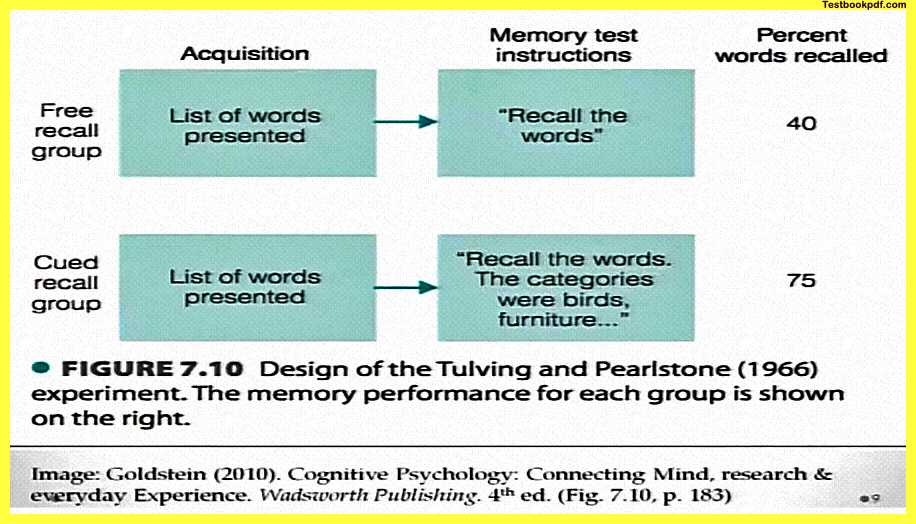
Now fill up those categories with whatever words from the list they remember that fall into this category what happened as a result you can already see that the percentage of words recalled are much better in case of queued recalled as compared to in a free recall so the results of this particular experiment twelve in persons experiment demonstrated that retrieval cues do aid memory participants in the freed recall group perform much worse than the participants in the queued recall group in another experiment mantilla 1986 presented his participants with a list of 600 nouns such as banana freedom tree and so on and so forth.
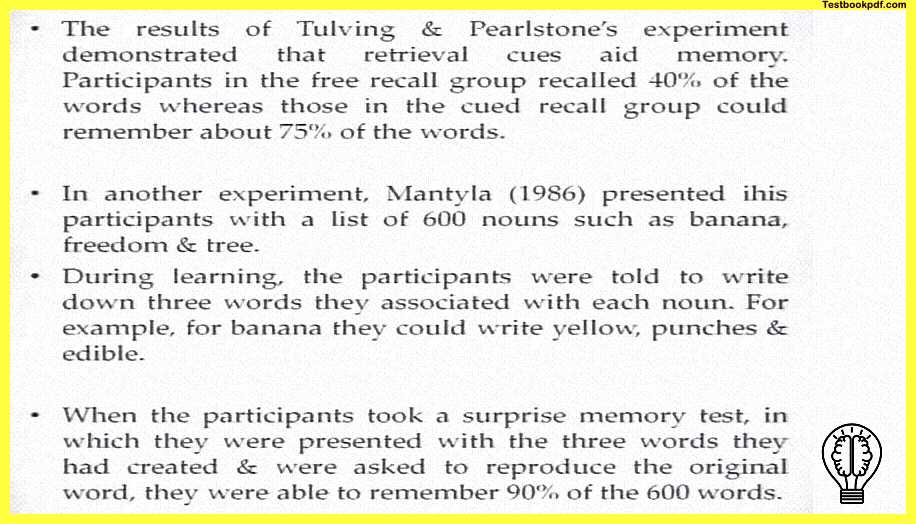
Now during the learning phase the participants were told to write down three words they could associate with each noun so that was for example for a banana they could write say for example it is yellow in color punches are made out of it and it is edible so any three words that the participant could generate themselves when the participants took a surprise memory test in which they were presented with three words they had created and asked to reproduce the original word they would remember are up to 90 percent of the 600 words that they were made to learn so here you can see the results if they were given cues that they had presented themselves their recall was around 90 percent if during learning they saw the banana and the queue is created by somebody else were given.
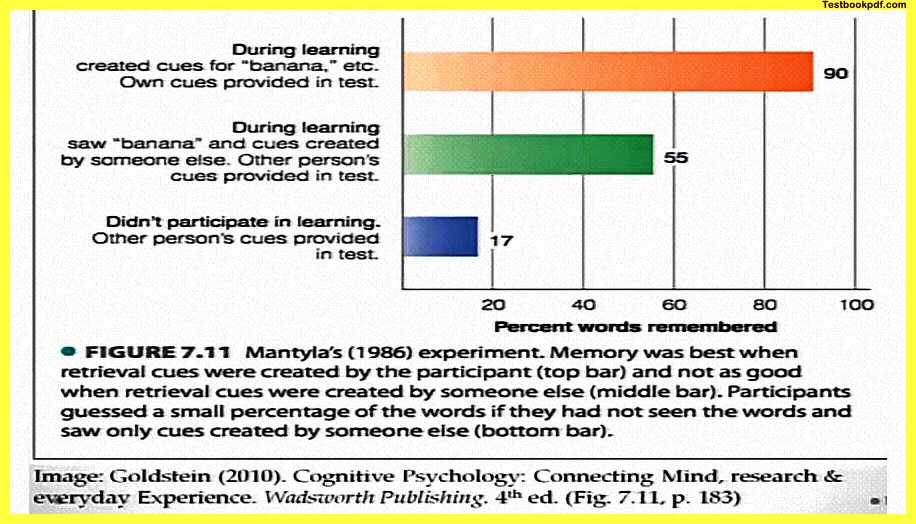
So somebody else kind of tries to give skews then the performance is slightly worse but it is very good but if there is no queue provided then their performance of recall is much lower its even less than 20 percent so you see that cued recall kind of helps participant retrieve information better information learned could be information could be learned to the almost the same extent but you do not have a proper retrieval queue to bring it out let us talk about some of the conditions wherein you can have good retrieval scenarios so one of the aspects of when you are matching encoding retrieval is this concept of encoding specificity.
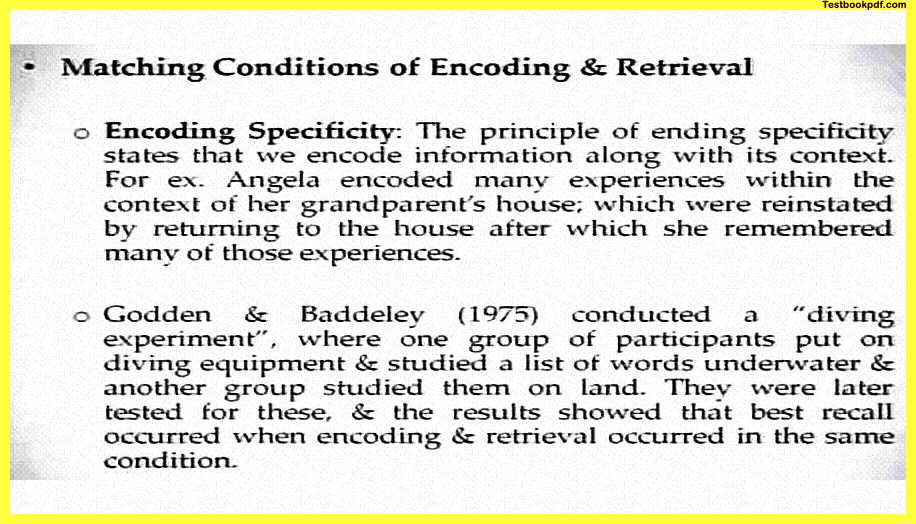
Now encoding specificity is basically when you are encoding or learning new information given a particular setting if you kind of revisit that setting that information becomes readily available to you and that information becomes more easily retrievable if you remember the child going to the grandparent’s house example given that the child was going through this house after 10 15 20 years and the child was interacting with objects that have been in the house since that time all of those objects are acting as retrieval cues for the memories of that time but that entire setting that entire presence in say, for example, one of the rooms, where the child would have lived or played that entire setting basically, makes this available because the information was encoded or learned or the experience had been gone through in that room.
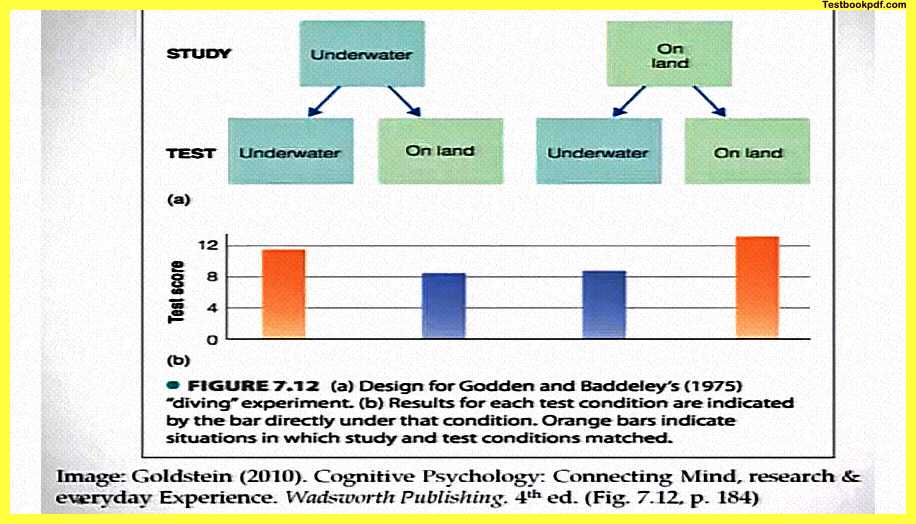
So that is basically an example of what encoding, encoding specificity could be like got in and badly in 1975 they conducted what is called a diving experiment wherein one group of participants put on diving equipment and studied a list of words while they were underwater and another group of participants studied the list of words when they were on land they were later tested for both of the groups who are tested for this list of words and the results showed that the best recall occurred when the encoding and the test conditions were matching so i will show you the results right here so you can see at the extreme left and extreme right both the parts the encoding and retrieval conditions have meshed and the performance is maximal another simple example of encoding specificity or a similar example to encoding specificity could be state-dependent learning.
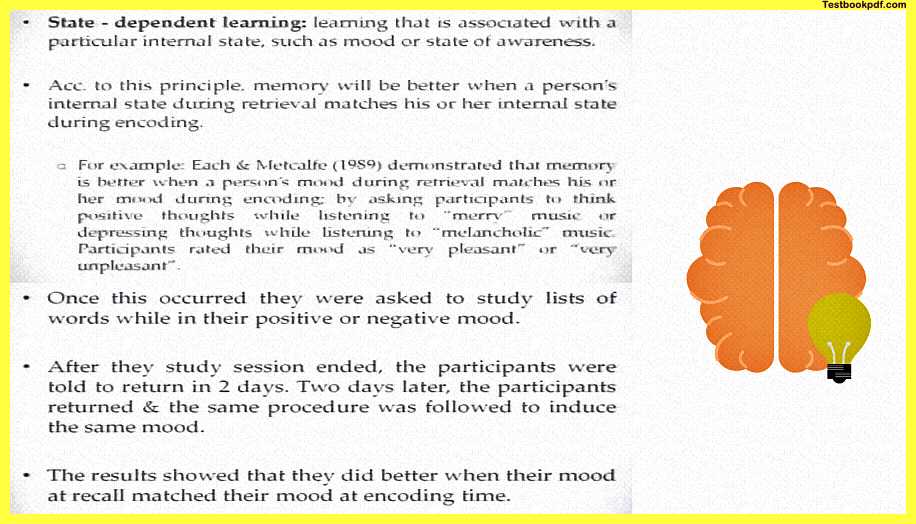
Now state-dependent learning is basically about that information that is learned in a particular internal state such as a mood or a state of awareness say for example if you are excited or happy or even angry and you are saying some things and some information is being told to you versus if you are in an awake state of awareness or you are slightly drowsy or if you are under the influence of some drugs or something information that you kind of are gaining under those states of awareness or under that under the influence of that particular mood will be very readily available to you once you are in that same mood again.
So according to this principle memory will be better when a person’s internal state during the encoding part during the retrieval part matches his or her internal state during encoding of that information so for example each and mid cuff basically they did this test they demonstrated that person’s memory is better when a person’s mood during retrieval matches his mood during the encoding part so they basically ask participants to think positive thoughts while listening to merry music or depressing thoughts while listening to melancholic music and then the persons were later asked to rate their mood so as very pleasant up to very unpleasant once this has occurred they were asked to study lists of words about positive or negative so once mood was established they were asked to memorize this list of words which were about while they were still in their positive or negative mood after this study session ended the participants were told to return after two days two days later when the partisans returned the same procedure was followed to induce the same mood.
So now what is happening is they are probably in the same mood as when they had learned that information the results showed that they did much better when their mood at recall was matching their mood when the encoding was happening here you can see again in the extreme right and extreme left you can see when the encoding mode and the retrieval mode matches the performance is better when the encoding mode and the retrieval mode does not match the performance is slightly lowered another aspect again of encoding specificity or a similar example could be transferred appropriate processing.
Transferred Appropriate Processing
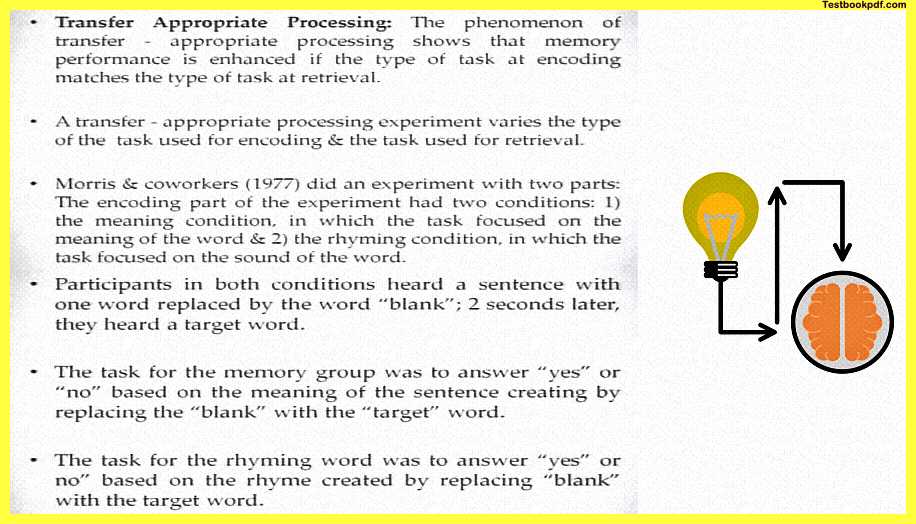
Now transfer appropriate processing is basically that memory performance is enhanced if the type of task at encoding matches the type of task at retrieval so if you are doing something say for example transfer an example of transfer appropriate processing could be said for example if you doing the same thing while you’re learning something and you’re doing the same thing while you’re retrieving so I’ll give you an example Morrison co-workers in 1977 they did an experiment with two parts the encoding part of the experiment had two conditions first was the meaning condition second was the rhyming condition in the meaning condition they had to focus on the meaning of the word in the rhyming condition they had to focus on the sound of the word so and demonstration could be something like this here you can see so the sentences this blank had a silver Indian.
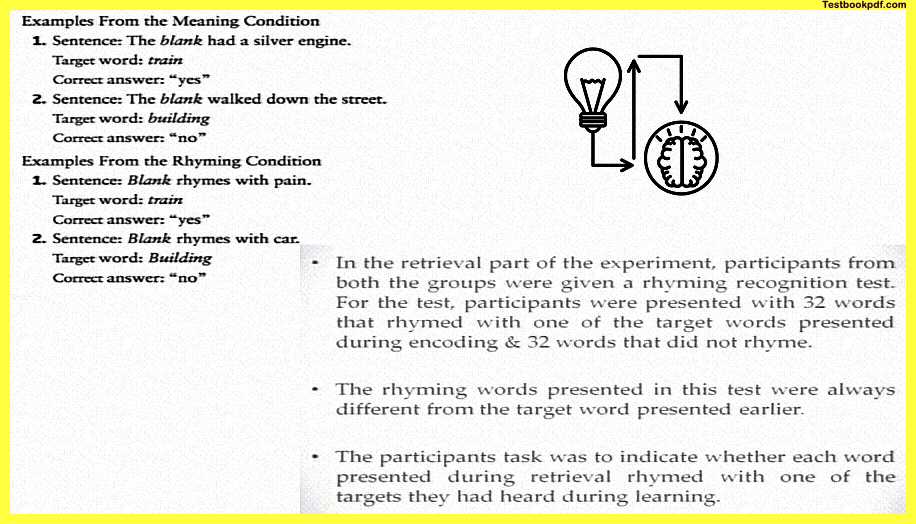
So what they have to do has just come back to the participants in the board conditions during the test part they heard a sentence with one word replaced by blank and two seconds later they heard a target word the task for the memory group was to answer yes or no based on the meaning of the word the task of the rhyming group was to answer yes or no based on the sound of the word now you see what the task is so from the meaning condition the sentence is the blank had a silver engine the target word is trained so now the person has to answer whether the meaning of the word train matches that blank similarly the blank walk down the street.
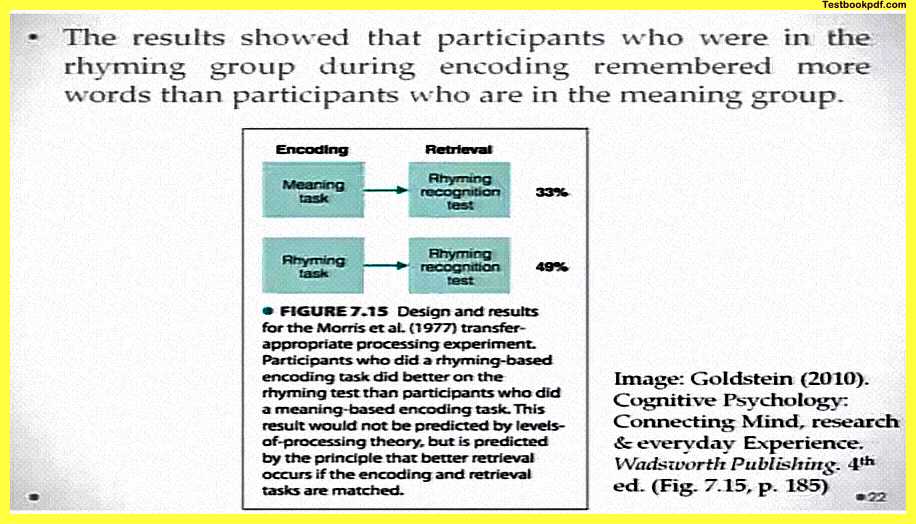
Now and the target word is building participant has to on the meaning of the word building and decide whether it can fit in that blank or not okay this is the meaning part the second part is the rhyming condition so blank rhymes with pain the partition and the target word are let us say train and the participant has to say yes train rhymes pain or maybe if there is another word it does not the second word is the blank rhymes with the car and the target word is building so now he has to say because the building does not rhyme with the car he has to say no so what you are seeing is in these two conditions the participant is doing something related to meaning in the second condition the particular is doing something related to the rhyme of these different words.
Memory and Brain
Now in the retrieval part of the experiment, encoding part in retrieval part of the experiment participants of both groups were given a rhyming recognition test so for the tests partisans were presented with 32 words that rhymed with one of the target words during encoding and 32 words that did not rhyme so the list contained 62 words 32 rhymes with the target words 32 and 1 did not and the other 32 did not the rhyming words presented in this test because it is a new case is always different from the rhyming words were presented during the target which was presented earlier.
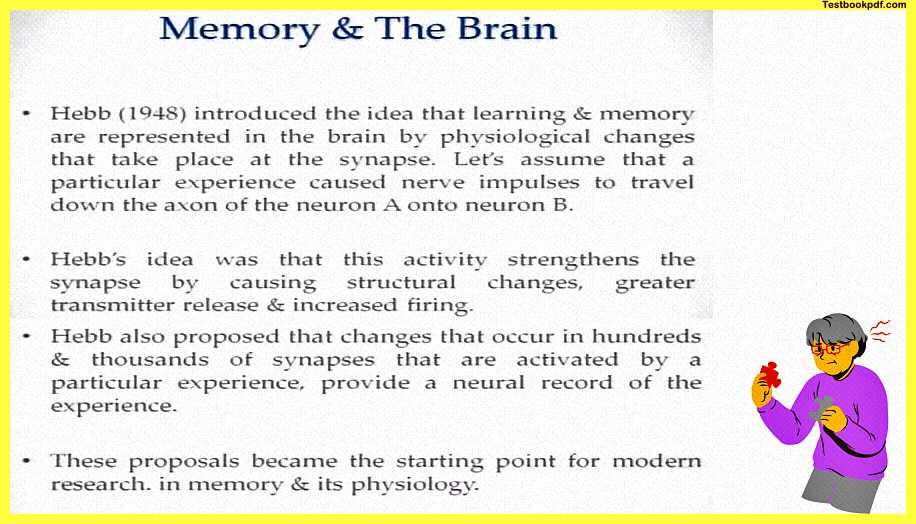
So participant’s task was to indicate whether each word presented during retrieval rhymed with one of the targets that they had seen that they had heard during learning the results showed that the participants who were in the rhyming group during encoding remembered more words than the participants who are in the meaning group so encoding during meaning task and retrieval in the rhyming condition was much poorer encoding during rhyming task and retrieval during the rhyming task were much better now coming to memory and the brain Donald Hebb in 1948 introduced the idea that learning and memory are represented in the brain by physiological changes that take place that takes place during a synapse now if you remember the chapter we did on brain and behavior you might want to recall all of that for getting these concepts.
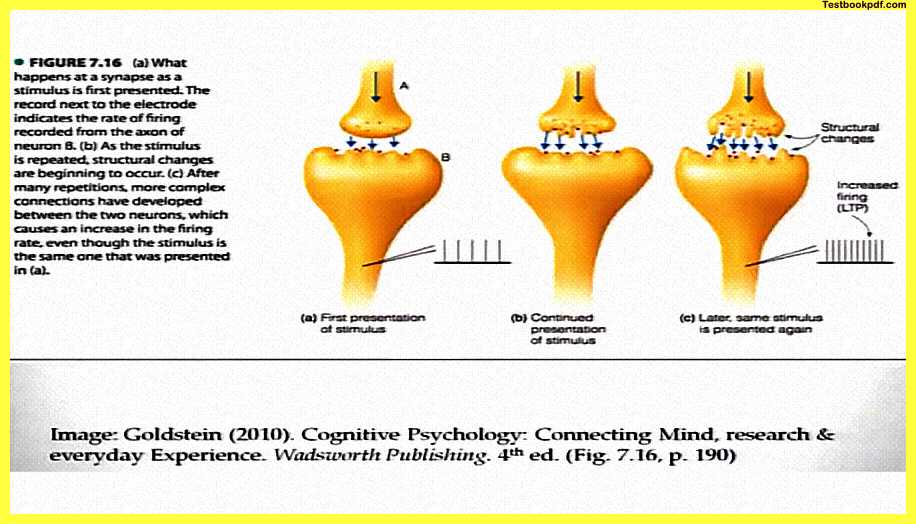
Now let us assume that a particular experience that when a particular experience happens neuron a fires and it causes sense and impulse to neutron b and then the neuron b as well fires so Hebb’s idea was that this activity strengthens the synapse by causing structural changes greater to neurotransmitter release and increased firing Heav also proposed that changes occurs in hundreds and thousands of synapses that are activated by a particular experience say for example if you are learning a particular skill if you are learning let us say sword fighting for the first time there are constantly a lot of changes that are going on in your brain with kind because you’re learning a completely different motor activity now these proposals became the starting point for modern research of memory and its physiology say for example here you can see that what is happening at a synapse and they are kind of trying to record this using some technique called single cell recording I’ll elaborate about this in in a while.
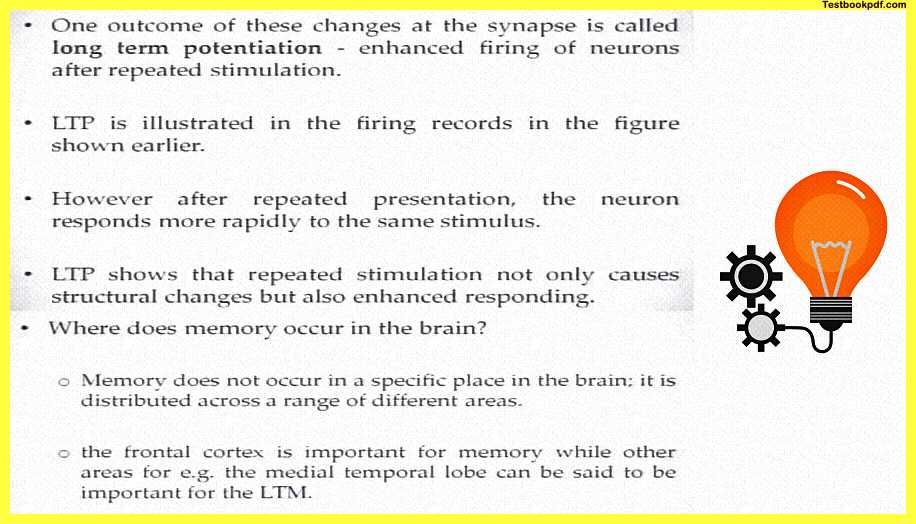
Now one outcome of these changes which Hebb is proposing happening at the synaptic level is called long term potentiation what is long term potentiation is basically enhanced firing of neurons after repeated stimulation say for example if you are learning one skill again and again and you are practicing again and again there is the neurons that fired in the first instance of learning that skill will fire again and again on the second third tenth and fifteenth instances of the same skill and in that sense they will basically learn that skill so in that sense your learning of that skill is being encoded at the neuronal level so LTP basically shows that repeated stimulation not only causes structural changes but it also leads to enhanced responding now if and i think this question a lot of people would have asked many a times that where does memory occur in the brain is it one part of the brain that all the memory for everything sits or is it say for example the entire brain that the memory sits how is it actually done.
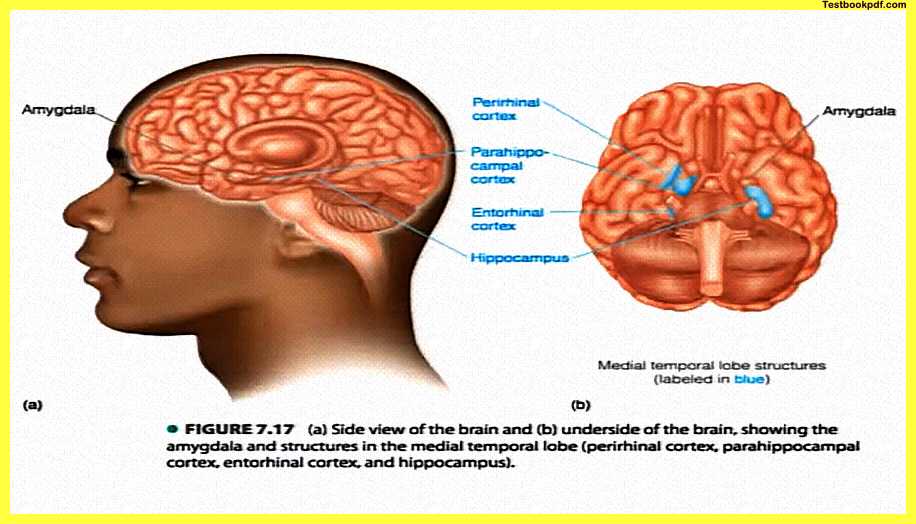
Now let me tell you that memory does not really occur in a specific site in the brain or a specific place in the brain it is distributed across a range of different areas the frontal cortex is important for memory while for other areas like the medial temporal lobe can also be said to be important for memory here you can see the perirhinal cortex the para hippocampus cortex the entire cortex the hippocampus and the amygdala are some of the structures which are considered very important as far as memory is concerned the medial temporal lobe houses the hippocampus it also houses what is called the perirhinal cortex.
Now Davachi and coworkers 2003 designed a study to determine how these areas respond to the names of the objects presented as part of a memory experiment so participants were shown around 200 words while they were in an fMRI scanner and they were instructed to create an image of a specific place that went along with each of these words say for example if you hear the word dirty you can imagine say for example a garbage dump or maybe a railway platform now 20 hours later the participants have presented a recognition test in which they had the same 200 words that they had learned during the earlier phase and with some to around 200 new words during this part of the experiment they were not in the scanner so the first testing phase was.
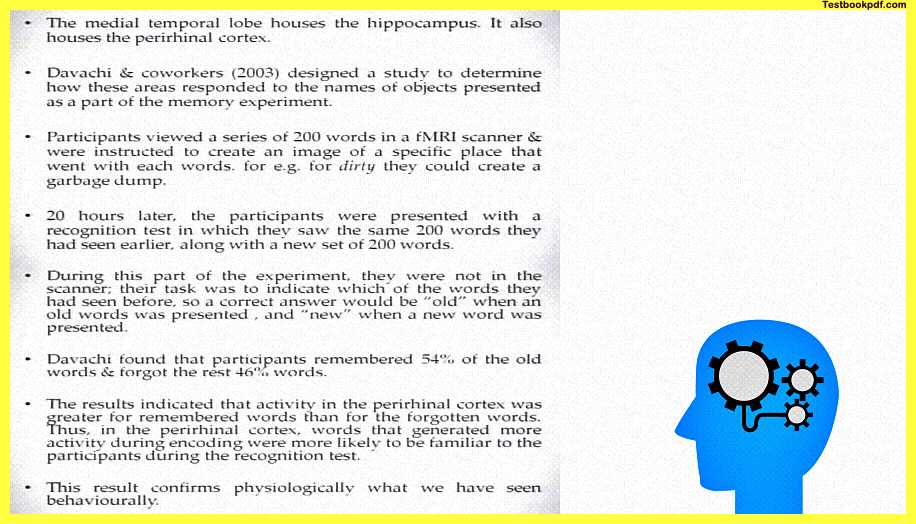
Now out of the scanner and they were basically talking about which of the words they had seen before so a correct answer would be old when the word presented was already seen earlier and knew when the word was not presented earlier Davachi found that parts must remember 54 of the older words and forgot the rest 46 of the words these results basically indicated that activity in the periodontal cortex was greater for remembered words than for forgotten words and so it could be concluded that the perirhinal cortex, in the perirhinal cortex the words that generated more activity during encoding were likely to be familiar to the participants during the recognition test.
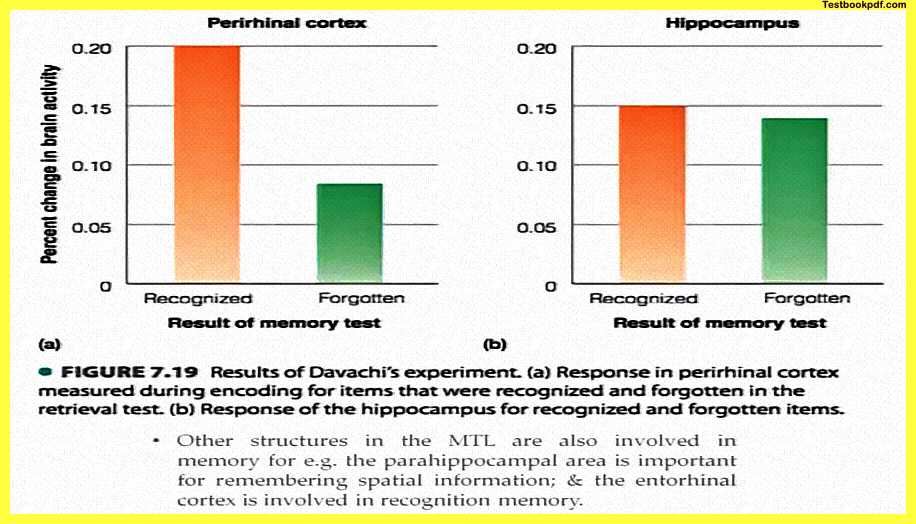
So what basically they found is those words that were old generated more activity in the perirhinal cortex those words that were new generated less activity in the periodic cortex so it kind of tells you that the perirhinal cortex is that area of the brain which kind of codes for familiarity which kind of kind will tell you that this is some stimulus I have interacted with earlier this is the setup of Davachi and colleagues study the participant is in the fMRI scanner and is imagining a place associated with this word so herein you can see the result structures in the medial temporal lobe are also involved in memory, for example, the para hippocampus area is important for remembering spatial information and the endo anal cortex is responsible for use in recognition memory.
What is memory consolidation?
Now let us talk about memory consolidation every time you retrieve some information you kind of need to re-consolidate that memory as well so consolidation refers to the process that transforms the newly formed fragile memories to a more stable and permanent state where they are more resistant to disruption or change so if you are going through a particular experience that memory will be formed but it needs to be consolidated before it kind of goes to the more stable and more permanent stage.
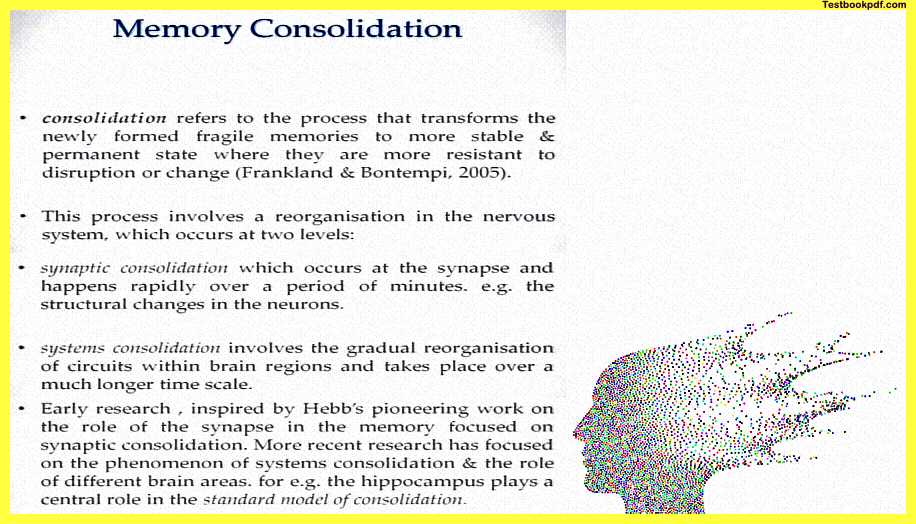
Now, this process involves reorganization in the nervous system which kind of occurs at two levels synaptic consolidation which occurs at the synapse level and happens rapidly over a period of minutes whatever structural changes are going on in the neurons with respect to that experience you are having second is systems consolidation which basically involves a gradual reorganization of the circuits within the brain regions and basically takes place over a much longer time skill so it’s kind of happening more gradually and kind of leads to better organization of that entire circuit early research inspired by his pioneering work on the role of synapse in memory focused on synaptic consolidation so early research is more about synaptic consolidation more recent research has.
Now focused on the phenomena of systems consolidation and the role of different brain areas or the entire networks in the brain areas and how they contribute to forming memories so the hippocampus plays a central role in the standard model of consolidation let me talk to you about what the standard model of consolidation is there are two theories the first is the standard model of consolidation and basically the point is the graded property of retrograde amnesia in which amnesia is worse for experiences that have occurred just prior to brain injury plus other evidence have kind of led to this model.
So the model kind of proposes that memory retrieval depends on the hippocampus during consolidation but once the consolidation is complete it does not in longer requires the hippocampus.
So incoming information is supposed to activate a number of areas in the cortex activation is distributed across the cortex because memory typically involves so many sensory areas getting activated and other cognitive areas in which you are thinking and deciding about these things.
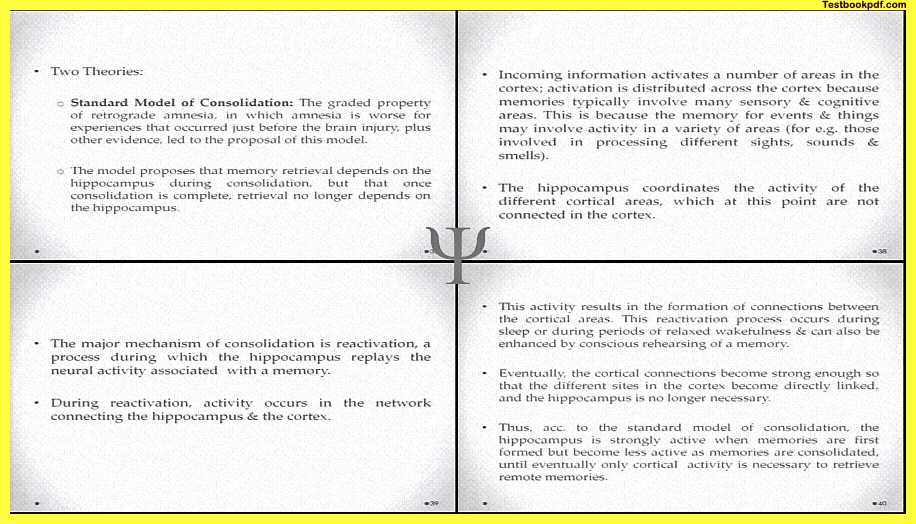
So this is because the memory for events and things may involve a lot of activity the hippocampus is kind of the area is going to coordinate this activity of these different cortical areas so there will be cortical areas related to the sensory information about this experience there might be cortical areas activated which have to do with the higher cognitive process like thinking deciding and those kinds of things hippocampus is the area which will coordinate this activity in this network of areas the major mechanism of reconsolidation is called reactivation a process in which the hippocampus is replaying this neural activity associated with a particular experience or memory during reactivation activity occurs in the entire network connecting the hippocampus and the cortex.
So this activity leads to the formation of connections between these cortical areas the major areas of the brain remember we are not talking about synaptic level connections here this reactivation process occurs during sleep or during periods of relaxed wakefulness and can also be enhanced by conscious rehearsing of memory so if you have learned something if you learn some material it might be a good idea to at some point in a relaxed state try and remember what all you learned during the class so what you might be doing is probably doing some kind of a systems consolidation wherein you are rehearsing this entire thing eventually the quarterly connections become strong enough so that the different sites in the cortex become directly linked and the hippocampus is no longer necessary so after the consolidation is done memory is placed and it’s in a distributed fashion across the brain you do not need the hippocampus again to bring out that memory.
So according to the standard model of consolidation, the hippocampus is strongly activated when the memories are first formed but much less active and the memories are consolidated until eventually only cortical activity is necessary to retrieve these remote memories this is kind of a representation of how over time these network cortical networks might get strengthened with respect to newer memories the other model is the multiple trace hypothesis according to the multiple trace hypothesis the hippocampus is involved in the retrieval of remote memories and especially episodic memories evidence for this idea comes from experiments like the one by giveaway and co-workers who elicited recent and remote episodic memories by showing participants photographs of when they were 5 years old till very recent photographs the result of this experiment showed that the hippocampus was active during both recent memories and remote memories.
Now the fact that there is evidence supporting both the involvement of the hippocampus in both recent memories and remote memories has led to a lot of discussion among memory researchers as to whether or not the hippocampus is involved during the retrieval of remote memories now an interesting concept of after consolidation is the concept of reconsolidation.
Nader and researchers
Now Nader and researchers have worked in this area and they propose that once a memory is reactivated it must undergo what is called a reconsolidation which is a similar process to consolidation that occurred after the initial learning but this happens much more rapidly so one can say that memory becomes susceptible to being changed or disrupted every time it is received every time it is retrieved every time you kind of remember something again it might be susceptible or amenable to change your manipulation so reconsolidation might provide an opportunity for reinforcing or even updating new memories, for example, an animal that returns to a location of a food source and finds that the food has been moved to a different place can kind of benefit with reconsolidation he’ll update the new memory with the fact that.
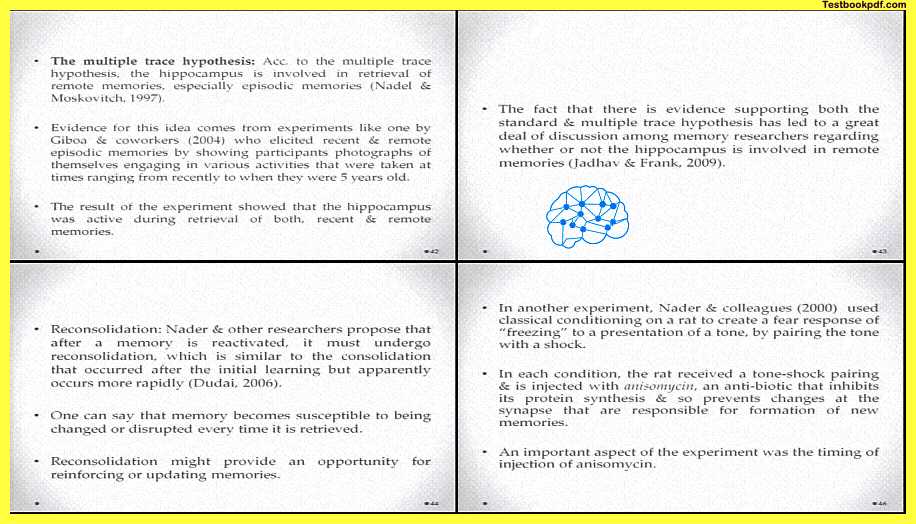
Now the food is not here it is probably moved to location b so this update will happen and the updated memory will be reconsolidated a good experiment was done by Nader and colleagues they used classical conditioning to create a fear response of freezing to the presentation of a tone so they did is they present they paired a tone and an electric shock for a rat and then what they did was they injected the rat with anisomycin.
Now an isometric is an antibiotic that inhibits protein synthesis and prevents the formation or consolidation of memories an important aspect of this experiment was around the timing of when the injection of anisomycin is given in condition one the rat received the pairing of the tone and the shock on day one and received the animation on day two on day three it was checked it was played the tone was played and it was checked that the rat did freeze to the tone this is expected because conditioning already happened on day one and anisomycin was not injected until day two in condition two the rat receives the pairing of the tone on shown in shock on day one and is immediately injected with anisomycin on day three when the rat is tested with the tone it does not freeze because that connection between tone and shock was not formed as anisomycin was injected immediately in day three what happens the memory becomes reactivated and becomes more fragile just as it was immediately being formed.
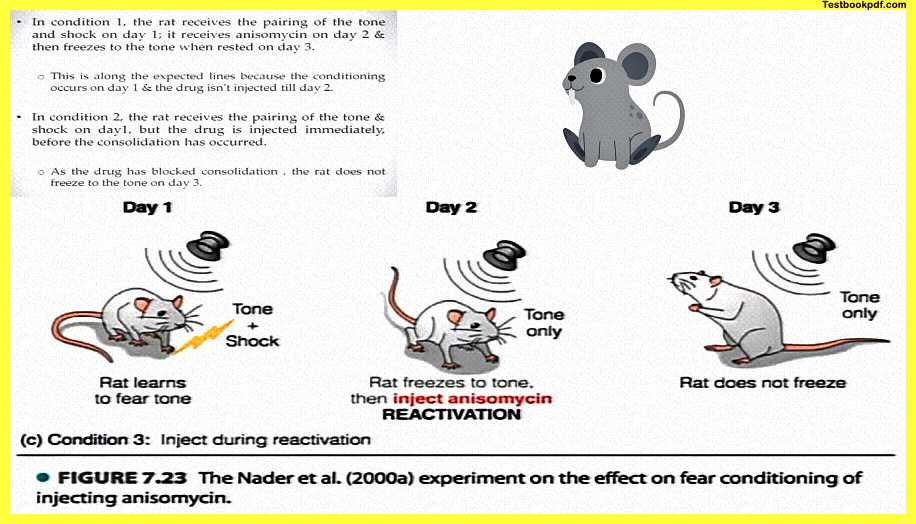
So what was happening is you kind of play the tone the rat is getting into the freezing behavior and then you place freezing inject anisomycin and then you see that the rat still freezes on day three because the activity, because the memory was not reconsolidated, does this occur in humans as well so another basically in an experiment Nazar thought that it does and in an experiment by hubbach and colleagues in 2007 it was shown that it actually happens with humans as well so this experiment was very simple a group of participants learned a list of words on day one on day two the other group.
No there are two groups reminder group and a non-reminder group on day two one of the groups learned the new list of words and the other group that was the reminder group learned the same list of words when on day three these two groups were asked to remember the last one the no reminder group recalled around five percent of the words from list one but mistakenly remembered five percent of the words from list two the reminder group recalled thirty-six percent of the words from list one but mistakenly they kind of remembered around forty and twenty-four percent of the words from list two.
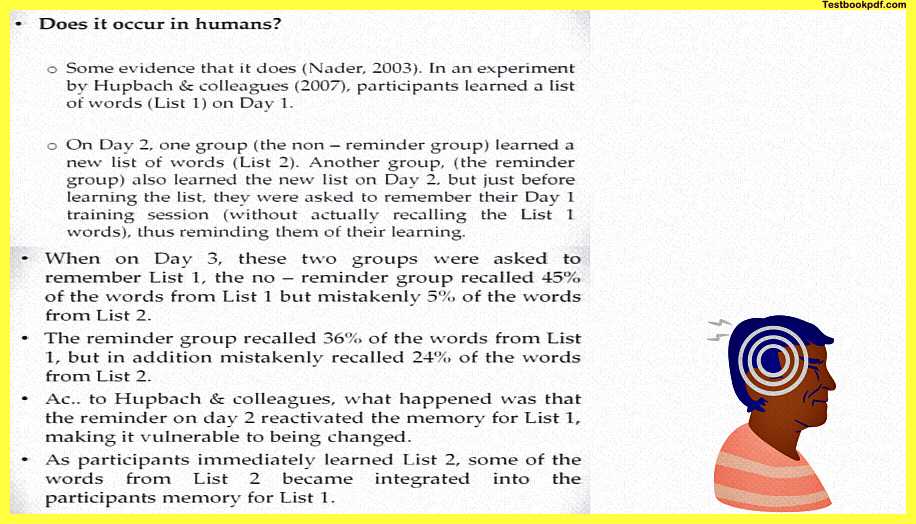
Now according to hubbach and clicks what happened was that the reminder on day two reactivated the memory for list one and it became vulnerable to change and in that sense, some of the words from the list2 kind of got mixed up with the words from list one and that is why they are mistakenly remembering more words from list two while they are being asked to recall list one as well a practical implication or outcome of research on reconsolidation is a possible treatment for post-traumatic stress disorder.
So clinical psychologist Allen bernard tested the idea that reactivation of memory followed by reconsolidation can provide a way to alleviate symptoms of what is called post-traumatic stress disorder this basically involves having a flashback of the traumatic event again and again the idea was to reactivate a person’s memory for the traumatic event and then inject probin all basically a drug which kind of blocks the production of a stress hormone in the amygdala.
PSTD
So what is happening is that he had two groups of PTSD patients both of them listened to a 30-second recording of themselves describing their traumatic experiences and while they are kind of relieving this experience they received probinol injection while the other group just received a placebo it was found one week later when both groups were told to imagine their traumatic experience again, again listening to this 30-second recording it is found and then to determine the reaction to the imagining this experienced skin conducting response and blood pressure were being monitored it was found that the propanol group experienced much smaller increases in their heart rate and skin conductance than the placebo group they showed that the reactivation of memory and the absence of reconsolidation and the presence of reconsolidation basically led to a significant decrease in the symptoms of PTSD even months after this particular treatment
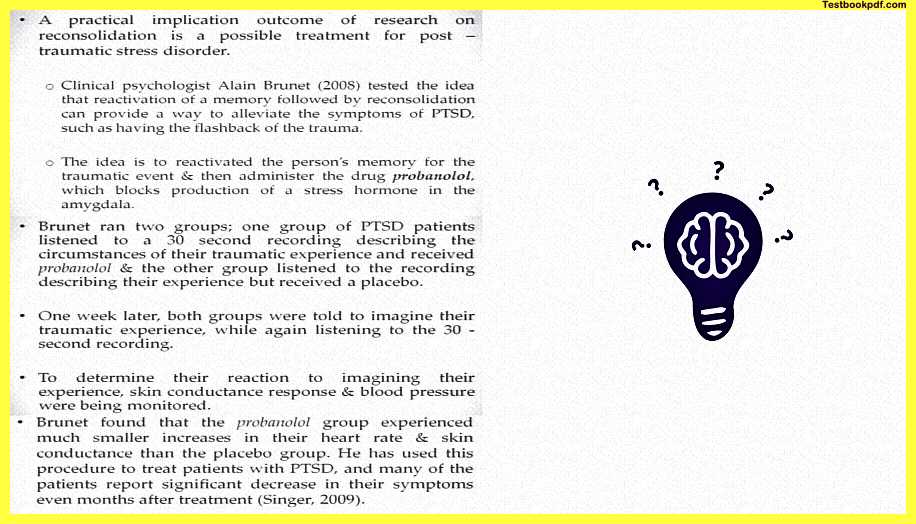
So you have talked about retrieval and how the brain kind of participates in memory in this article and I hope this whole point was clear to you and we will talk about other aspects of memory in the next article thank you.
Read also:
Memory Psychology Pdf Download (Part-1)
Memory in Psychology Pdf (Part-3)
Psychology Memory Pdf (Part-4)
Memory Psychology Example (Part-5)
